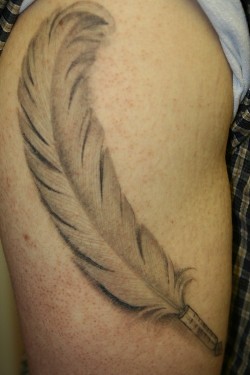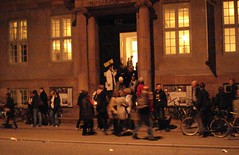 As usual, and as announced earlier, Medical Museion took part in the Copenhagen Night of Culture (Kulturnatten) — a mid-October Friday each year when hundreds of museums, galleries and other institutions in the inner city area are open all evening.
As usual, and as announced earlier, Medical Museion took part in the Copenhagen Night of Culture (Kulturnatten) — a mid-October Friday each year when hundreds of museums, galleries and other institutions in the inner city area are open all evening.
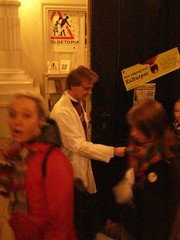 We didn’t have as many visitors as we use to have — ‘only’ slightly above 2000 passed through the doors during the six opening hours. We were not alone, however. This year’s Night of Culture was as a whole not as well-attended as in earlier years, for whatever reason. (Actually 2000+ visitors is much better both for us and our guests; it gives an opportunity to speak with at least a few individuals, and queuing isn’t a killer as it has sometimes been).
We didn’t have as many visitors as we use to have — ‘only’ slightly above 2000 passed through the doors during the six opening hours. We were not alone, however. This year’s Night of Culture was as a whole not as well-attended as in earlier years, for whatever reason. (Actually 2000+ visitors is much better both for us and our guests; it gives an opportunity to speak with at least a few individuals, and queuing isn’t a killer as it has sometimes been).
Here’s our administrator, Carsten, distributing visitor’s programmes.
 We had invited two choirs to perform in the old anatomical theatre — here’s Vokalgruppen Kolorit led by Niels Græsholm:
We had invited two choirs to perform in the old anatomical theatre — here’s Vokalgruppen Kolorit led by Niels Græsholm:
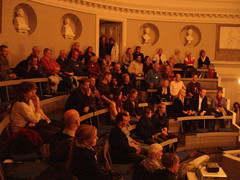
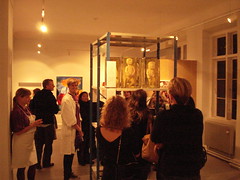 Together with one of our student guides (Sune), our conservators, Ion and Nicole, had express-built an ingeniously simple, yet very functional, storage case for some of our precious anatomical artefacts (wet specimens on the top):
Together with one of our student guides (Sune), our conservators, Ion and Nicole, had express-built an ingeniously simple, yet very functional, storage case for some of our precious anatomical artefacts (wet specimens on the top):

 As usual, our staff was spread out all over the house. Here Søren explains 18th century surgical practices
As usual, our staff was spread out all over the house. Here Søren explains 18th century surgical practices
 and here Martha measures her hands against those of Seneca in the ‘Oldetopia’ temporary exhibition.
and here Martha measures her hands against those of Seneca in the ‘Oldetopia’ temporary exhibition.
Like last year, the Director of Danmarks Lungeforening, Charlotte Fuglsang and her staff did their best to test as many visitors as possible for chronic obstructive pulmonary disease (often a result of the filthy habit of smoking):
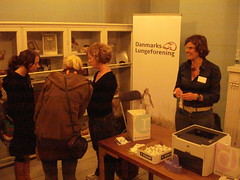
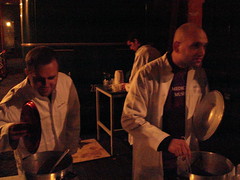
while the Glühwein crew (Thomas, Bjørn and Niels Christian) did their best to sabotage Danish public health by seducing bypassers to the dangerous habit of alcohol consumption,
 and Emil and Sven Erik resorted to the even more dangerous habit of consuming large amounts of crisps during a short break in the staff kitchen.
and Emil and Sven Erik resorted to the even more dangerous habit of consuming large amounts of crisps during a short break in the staff kitchen.
Here our technician, Folke, guides people in the right direction:
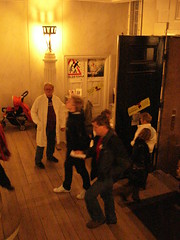
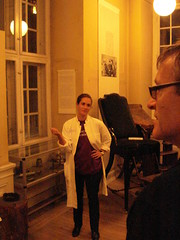
One of our student guides, Ditte, explains the history of epidemic diseases to visitors:
while Jonas tells dramatic stories about 19th century miasmas:
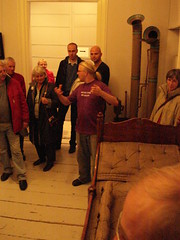
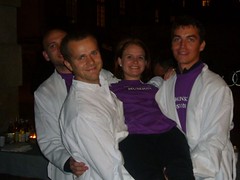 And finally, in the hands of the Glühwein crew: Monica, our administrative assistant, who did a marvellous job planning the whole operation:
And finally, in the hands of the Glühwein crew: Monica, our administrative assistant, who did a marvellous job planning the whole operation:
(the white hospital coats and lila T-shirts with the Medical Museion logo was yet another of Monica’s innovative ideas for this year’s Night of Culture in Copenhagen)

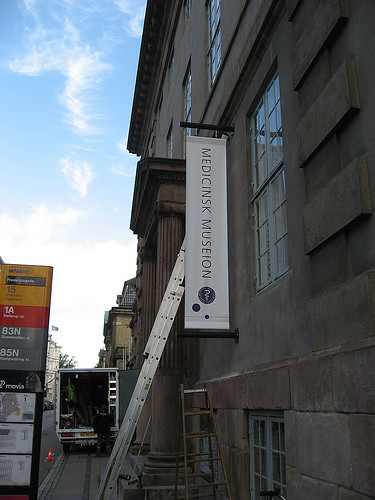
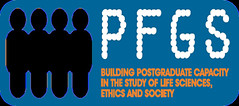 On 11-12 December, the Postgraduate Forum on Genetics and Society — set up ten years ago to “bring together researchers interested in how biosciences and society(s) intersect” — organizes a colloquium at Lancaster University on the theme ‘Social and biosciences – a critical collaboration’. Keynote speech from Steve Sturdy (Genomics Forum Deputy Director), panel session with Richard Tutton (Lancaster), Niall Scott (Uclan) and Adam Hedgecoe (Sussex), and presentations by Paul Oldham and Dita Wickins-Drazilova (both Lancaster). They’re expecting student presentations too (deadline for abstracts is 7 November). Read more about the Forum and the December meeting here:
On 11-12 December, the Postgraduate Forum on Genetics and Society — set up ten years ago to “bring together researchers interested in how biosciences and society(s) intersect” — organizes a colloquium at Lancaster University on the theme ‘Social and biosciences – a critical collaboration’. Keynote speech from Steve Sturdy (Genomics Forum Deputy Director), panel session with Richard Tutton (Lancaster), Niall Scott (Uclan) and Adam Hedgecoe (Sussex), and presentations by Paul Oldham and Dita Wickins-Drazilova (both Lancaster). They’re expecting student presentations too (deadline for abstracts is 7 November). Read more about the Forum and the December meeting here:  As usual, and as
As usual, and as  We didn’t have as many visitors as we use to have — ‘only’ slightly above 2000 passed through the doors during the six opening hours. We were not alone, however. This year’s Night of Culture was as a whole not as well-attended as in earlier years, for whatever reason. (Actually 2000+ visitors is much better both for us and our guests; it gives an opportunity to speak with at least a few individuals, and queuing isn’t a killer as it has sometimes been).
We didn’t have as many visitors as we use to have — ‘only’ slightly above 2000 passed through the doors during the six opening hours. We were not alone, however. This year’s Night of Culture was as a whole not as well-attended as in earlier years, for whatever reason. (Actually 2000+ visitors is much better both for us and our guests; it gives an opportunity to speak with at least a few individuals, and queuing isn’t a killer as it has sometimes been). We had invited two choirs to perform in the old anatomical theatre — here’s
We had invited two choirs to perform in the old anatomical theatre — here’s 
 Together with one of our student guides (Sune), our conservators, Ion and Nicole, had express-built an ingeniously simple, yet very functional, storage case for some of our precious anatomical artefacts (wet specimens on the top):
Together with one of our student guides (Sune), our conservators, Ion and Nicole, had express-built an ingeniously simple, yet very functional, storage case for some of our precious anatomical artefacts (wet specimens on the top):
 As usual, our staff was spread out all over the house. Here Søren explains 18th century surgical practices
As usual, our staff was spread out all over the house. Here Søren explains 18th century surgical practices and here Martha measures her hands against those of Seneca in the ‘Oldetopia’ temporary exhibition.
and here Martha measures her hands against those of Seneca in the ‘Oldetopia’ temporary exhibition. 

 and Emil and Sven Erik resorted to the even more dangerous habit of consuming large amounts of crisps during a short break in the staff kitchen.
and Emil and Sven Erik resorted to the even more dangerous habit of consuming large amounts of crisps during a short break in the staff kitchen.


 And finally, in the hands of the Glühwein crew: Monica, our administrative assistant, who did a marvellous job planning the whole operation:
And finally, in the hands of the Glühwein crew: Monica, our administrative assistant, who did a marvellous job planning the whole operation: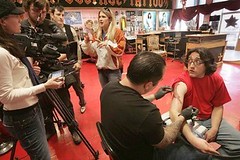 That’s why I was intrigued to see a recent example of how tattooing can be used to express medical self-identity. In an interview in the
That’s why I was intrigued to see a recent example of how tattooing can be used to express medical self-identity. In an interview in the 